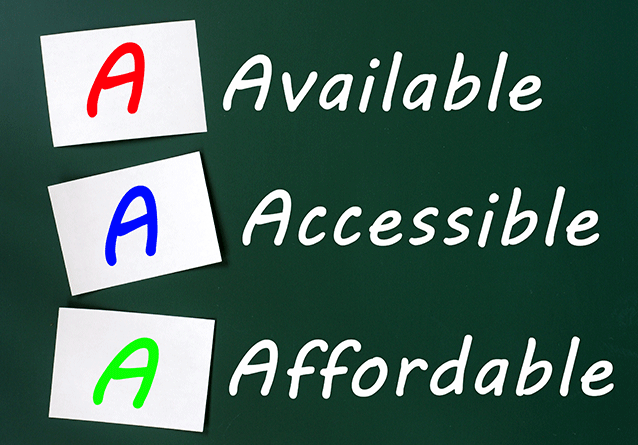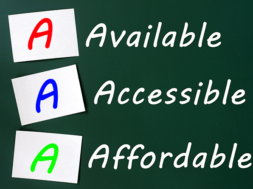
Inclusive Access: Is it the Answer to Course Materials Accessibility and Affordability Challenges?
By Bruce Schneider, Vice President of Business Engineering, Ambassador Education Solutions
Accessibility and affordability are two staples of a course materials program, yet two things that continue to challenge institutions and students alike. Emerging technologies, new regulations and evolving student demands impact accessibility. At the same time, some students shy away from purchasing their course materials, mostly due to cost.
The impact of these trends can be drastic. After all, studies show that students who are prepared on the first day of class with their materials have a greater chance of success.
Students want the lowest prices and crave ease-of-use, while schools want to make sure students have the materials they need to thrive.
Whether the challenge is accessibility or affordability or both, schools around the country are taking a hard look at their course materials programs and seeking innovative models that put the right materials in students’ hands, the right way and at the right price. Enter: Inclusive Access.
What’s causing all of the stress?
Students are more mindful than ever of college expenses. Consider the fact that college tuition has increased substantially over the last 30 years. Now couple this with the fact that a significant number of students are financially independent and almost two-thirds of students work while taking classes. To complicate matters, course materials costs add tension to an already stressful financial situation.
According to a Wakefield Research study, 85 percent of U.S. college students have either postponed buying required materials or chosen not to buy them at all. Of those students, 92 percent said the cost was the basis of their decision to delay the purchase or even skip it altogether.
Those students who have a vested interest in purchasing course materials are spending an exhaustive amount of time researching their options to try to get the best price possible. This same study concluded that 70 percent of students surveyed consult at least three sources when shopping for course materials. The downsides of shopping around are many. Not only is availability outside of the school’s control, but students also might end up with outdated editions. Additionally, because students rarely find all of their materials through a single seller and because students are subject to the shipping policies of each seller, total shipping costs tend to be higher and timelines longer.
Delaying the purchase of or not buying materials at all is a trend that can have a direct impact on retention and outcomes. Most educators agree that course materials do matter and when students have their course materials they do better in class.
How are schools responding?
To best position students for success, more and more schools are showing interest in Inclusive Access. These automatic fulfillment programs not only ensure each and every student has his or her materials in hand before the first day of class, but they also lower costs because more students are purchasing materials. Additionally, they provide a simpler and more personalized student experience.
Under an Inclusive Access Model, schools select and purchase all required course materials on behalf of their students, and they roll the cost of the items into tuition, such as a course or a technology fee.
There are no limitations to the type of items that may be included in an Inclusive Access program, such as print textbooks, eBooks, eBooks with a Print-On-Demand (POD) option, digital content, and a variety of non-book items. Students automatically receive their course materials in time for the start of class.
An important aspect of an Inclusive Access program is the Opt-Out Cycle, whereby government regulations mandate that students have the option to decline their materials, with some exceptions such as custom items that are not readily available elsewhere. Few students actually opt-out because they value the convenience of having their materials automatically made available to them at a price they find attractive.
Why does inclusive access work?
Inclusive Access is an ideal way to improve accessibility and affordability. Programs at all types and sizes of schools report that their Inclusive Access programs enhance learning outcomes while driving down costs.
For starters, Inclusive Access is convenient. Students don’t have to take the time to search for their materials or compare options and costs. Delivery is accelerated as students automatically receive materials in time for the first day of class.
Students also recognize the importance of having immediate access to their course materials and the impact that can have on course performance. In fact, 7 in 10 students say they would have better grades if they had access to required course materials before the first day of classes.
Faculty appreciate Inclusive Access as well because it means that not only will students come to class prepared, but all students also work from the same version or edition. This makes it easier for instructors to align lectures and discussions with course materials, while also tracking student engagement and delivering a more consistent learning experience.
There are financial benefits for schools too. From a cost perspective, more students buying in means schools can lower costs all around. Schools receive revenue from a larger number of students and the lower margins are mitigated by lower overhead. Additionally, automatic de-duplication of materials eliminates the potential of double payments by schools, which can be a logistical headache to reconcile.
About Ambassador
From print and digital to inclusive access, OER and more, Ambassador simplifies course materials adoption, management and delivery. Integrated with leading SIS, LMS, Financial Systems, eBook Readers, Publishers and Ambassador’s Digital Content Platform, we connect students with course materials, driving down costs and improving outcomes. With Ambassador, course materials are simple, effective and affordable. Learn more at www.ambassadored.com.
What should you know when pursuing inclusive access?
Cost and convenience seem to be the two primary drivers of the recent Inclusive Access phenomenon, yet long before this automatic fulfillment model was on schools’ radars, Ambassador was powering successful, compliant Inclusive Access programs as a means to lower costs and improve outcomes. Our team has learned a lot over the last 15 years:
- Students are busy, most balancing work, school and family. Anything educators can do to make things easier is a win-win. Inclusive Access eliminates the stress as students don’t have to search for the right titles, they don’t have to shop around for the best price, and they don’t have to worry about not being prepared for class.
- Students apply the same customer service expectations that they have for third-party eCommerce to their school. Just because Inclusive Access automates the acquisition process, student and faculty support is still of the utmost importance.
- Integration is key. Leveraging a course materials provider’s integrations with a school’s SIS, LMS, financial systems, engagement apps, eBook readers, publishers and digital content platforms makes it easier for students to obtain materials or complete the opt-out cycle. It also increases accuracy, expedites processes and eases data collection.
- Analytics play an important role in making sure students and schools alike are successful. Having the right processes in place backed by detailed analytics allows schools to more accurately track data. Through these key insights schools can measure and improve outcomes, as well as ensure they don’t overpay publishers and vendors.
- Keeping costs and operational expenses in check allows schools to pass along the best possible price to students. Providing faculty with cost transparency so they can choose materials wisely is imperative, as is implementing a pricing structure whereby the school sets the student sell price.
Inclusive Access makes the course materials acquisition process seamless when schools partner with experienced course materials providers that have proven, reputable management and fulfillment technology and a student-centric focus.
Knowing that students are more likely to use and benefit from their course materials when they have them readily available, and knowing that 73 percent of students are interested in paying for course materials as part of tuition, makes a solid case for Inclusive Access. Addressing accessibility and affordability head on, Inclusive Access helps schools position their students for success.
BRUCE SCHNEIDER a distinguished speaker and published writer in higher education, has spent more than a decade in the technology group at Ambassador assisting in the development of its integrated course materials service solutions and helping customer institutions improve the quality of the student experience at all levels of the course material supply chain.
Contact Information: Bruce Schneider // Vice President of Business Engineering // Ambassador Education Solutions // 631-770-1010 // bschneider@ambassadored.com // www.ambassadored.com // @ambassador_ed










